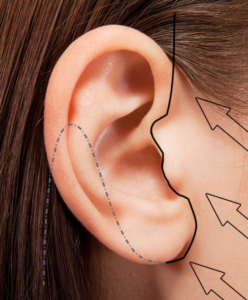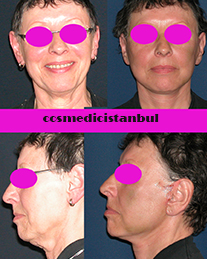Face Lift Surgery

The natural aging process leads to more or less pronounced wrinkles on the face and neck, which can greatly change your appearance. The skin elasticity is lost and the muscles of the subcutaneous tissue relaxes. It creates the impression that there is too much skin, which sags downwards following gravity. With a facelift, you can largely iron out these signs of the times. You will look younger and brighter and you will probably feel younger too. Whether and at what age you make a facelift depends solely on your personal desire to correct existing signs of aging. The typical facelift does not exist. It always depends on what changes you personally want. With a firming of the forehead, the eyebrows are raised and the frown lines are smoothed. Temporal lifting additionally leads to a tightening of the eye area. The cheek lift not only removes the wrinkles in this region, it also restores the fatty tissue that has slipped down the zygomatic arch. When tightening the neck, excess fat can be removed through another small incision under the chin. The so-called mini-lifting takes place mainly in the area of the temples and is only useful if no major changes are to be eliminated. face lift Normally, the facelift tenses your temples, cheeks, and neck all at once, with an additional shift in the superficial muscles. Through this intervention in the superficial musculo-necrosis system (SMAS), a significantly better tension is achieved overall. The lifting of one or more facial regions can be supplemented by further interventions (like eyelid surgery). Due to the facelift, no tightening of the fine wrinkles around the mouth and eyelids is to be expected. If you find these troublesome, other methods (abrasion or chemical peeling) must be used. Before you have a facelift, you should consult with your surgeon. This will allow you to find out in detail about the different methods and work with the surgeon to determine how best to achieve the desired results.
Before face lift bear in mind
Which results can be achieved with the facelift?
With a facelift, the skin is toned and your appearance rejuvenates for up to ten years. However, the natural aging process of the skin can not be completely stopped by a lift. How long the result of a lift will last depends on your individual equipment and the condition of your tissue. Usually, it is not a problem to repeat the operation after eight to ten years. In order to maintain your natural facial expression, you will still have some wrinkles after the procedure. If all wrinkles were rigorously finished, they would have a mask-like appearance. Here, the skill and experience of your surgeon is crucial to the success of the surgery.
Anesthesia form and hospital stay
The procedure of facelifting is usually performed inpatient and can be performed either under general anesthesia or under local anesthesia with sedation. The operation takes about three to four hours. The necessary preliminary examinations are carried out the day before your appointment in the clinic. You also have the opportunity to discuss the anesthetic with the specialist. Depending on the procedure, a hospital stay of 1 to 2 days is to be expected.
How do I prepare for the operation?
As a smoker you should stop smoking at least four weeks before your appointment in order to avoid the risk of wound edge necrosis. For a period of 14 days before surgery, you should be aware of painkillers such as aspirin like blood thinner, as they delay the blood clotting. Alcohol and sleeping pills should be largely avoided. If you are wearing your hair very briefly, you may want to let it grow a little to better conceal the surgical scars.
How is the operation going?
The surgeon sets the cuts in the same way as he discussed them with you before. By the way, it is not necessary to shave the hair before the procedure. The normal incision extends from the temples hair about five-six cm behind the hairline, passes in front of the ear and then ends behind the ears in the neck. In a forehead lift, the cut is at peak height and extends from one ear to the other. The skin is removed from the underlying tissue along the incision line, and the connective tissue beneath the skin, the relaxed facial expressions and deep-set flaps can be corrected. Thin threads fix the deep-set connective tissue as well as the musculature in their original place. Especially on the forehead, in the cheek area and in the eye area, many of these corrections can be made endoscopically today. This method has the advantage that the cuts are much smaller. After closing the wound edges with submerged dissolvable sutures and intracutaneous sutures, you will usually receive two drains and a light bandage around the head. Overall, the operation takes about three to four hours depending on the extent. During this time, the surgeon has fine sculptural work to do. His skills, his experience and his aesthetic feeling determine the result of your facelift.
What happens after the operation?
After surgery, your skin will be tense and swollen. Also, bruising around the cheeks and under the chin, as well as a slight numbness of the entire facial area are completely normal. The strongest puffiness occurs one to two days after the procedure and can temporarily change the appearance of your face. The swelling will return within the next two to three weeks. Also, do not worry if you feel pain behind the ear. They are caused by the tension with which the skin was fixed. A final result can only be assessed after a few months, depending on the extent of the procedure.

Which risks should you consider?
If you are allergic to certain medicines or care products or if you have other known illnesses, you must notify the doctor in any case. If you have noticeable bruises or if you have persistent bleeding after minor injuries, a coagulation disturbance before the operation should be excluded by appropriate examination. You should also tell your surgeon if you are planning to lose much weight because it may change the outcome.

What complications can arise during a facelift?
After a major facelift or forehead lift, the skin feeling in front of the ears or on the forehead may be impaired in the long term. Any bruising that may occur postoperatively can significantly delay the healing process and is therefore removed by a small surgical procedure. Under the strong tension of the facial skin it can occasionally come to hair loss in the temple area. However, the hair will grow back over the next few months. Circulatory disorders of the skin as a result of excessive nicotine consumption can lead to wound edge necrosis and eye-catching scars. These may need to be aftertreated. If bacterial infections occur, delaying secondary healing of the wound can lead to broader scars. These can be corrected by another small intervention. Damage to the facial nerves, which are almost excluded in expert hands, generally regenerates within three to six months. Occasionally lesions of skin and muscle nerves can occur, but these regenerate independently within weeks to months. A permanent disorder of the facial muscles caused by nerve injuries is an extremely rare complication.
What should be considered after the facelift?
The period of time until complete regeneration can be very different depending on the individual disposition and extent of the intervention. After the facelift you should definitely allow yourself rest for at least five to seven days. During this time you should not burden your skin with creams or ointments. Your skin helps itself best. After just eight days, you can shower as usual and put on make-up. Do not use nicotine and painkillers during the first four weeks. Direct sunlight should be avoided for a period of four weeks. If you expose yourself to the sun during the following weeks, sun protection with a high sun protection factor is recommended. Most of the time you can resume your sporting activities after four weeks. A medical consultation is still advisable.
Which after treatment is required?
The dressing and, if necessary, the drains are removed as early as two days after the facelift, and the sutures can usually be removed after ten days.

Free Consultation

